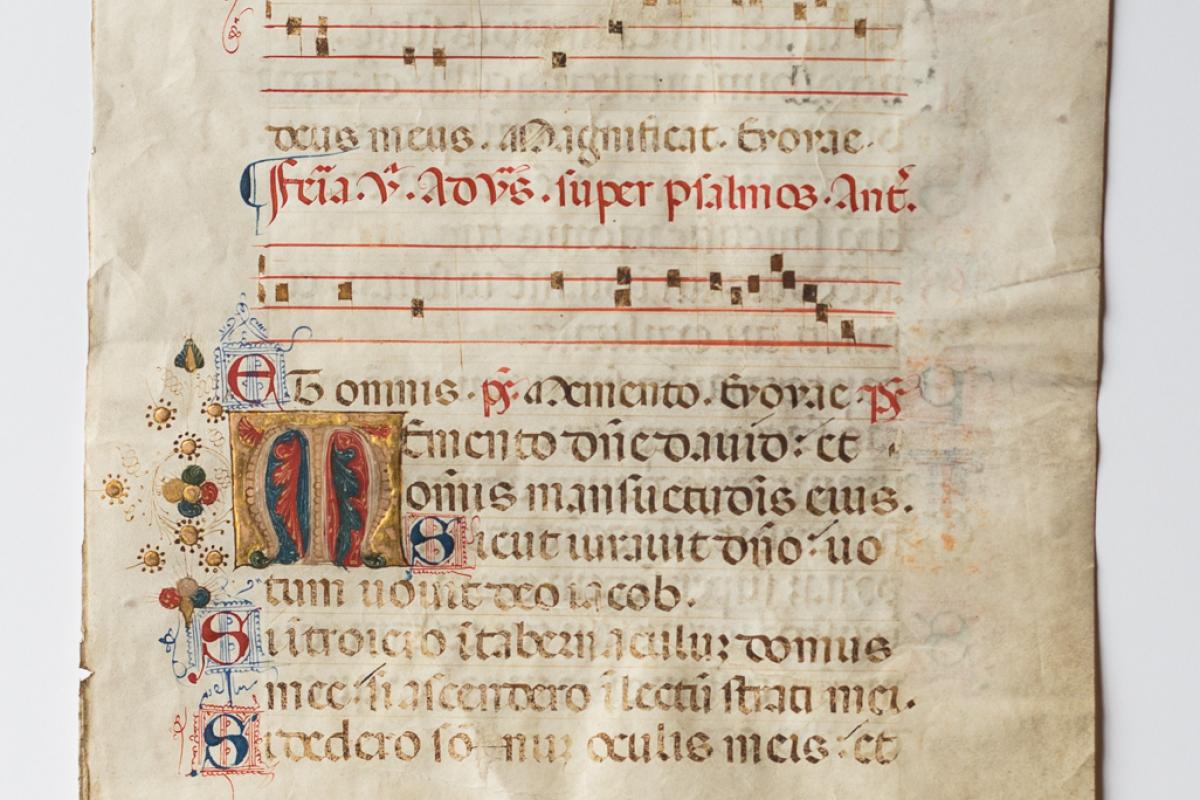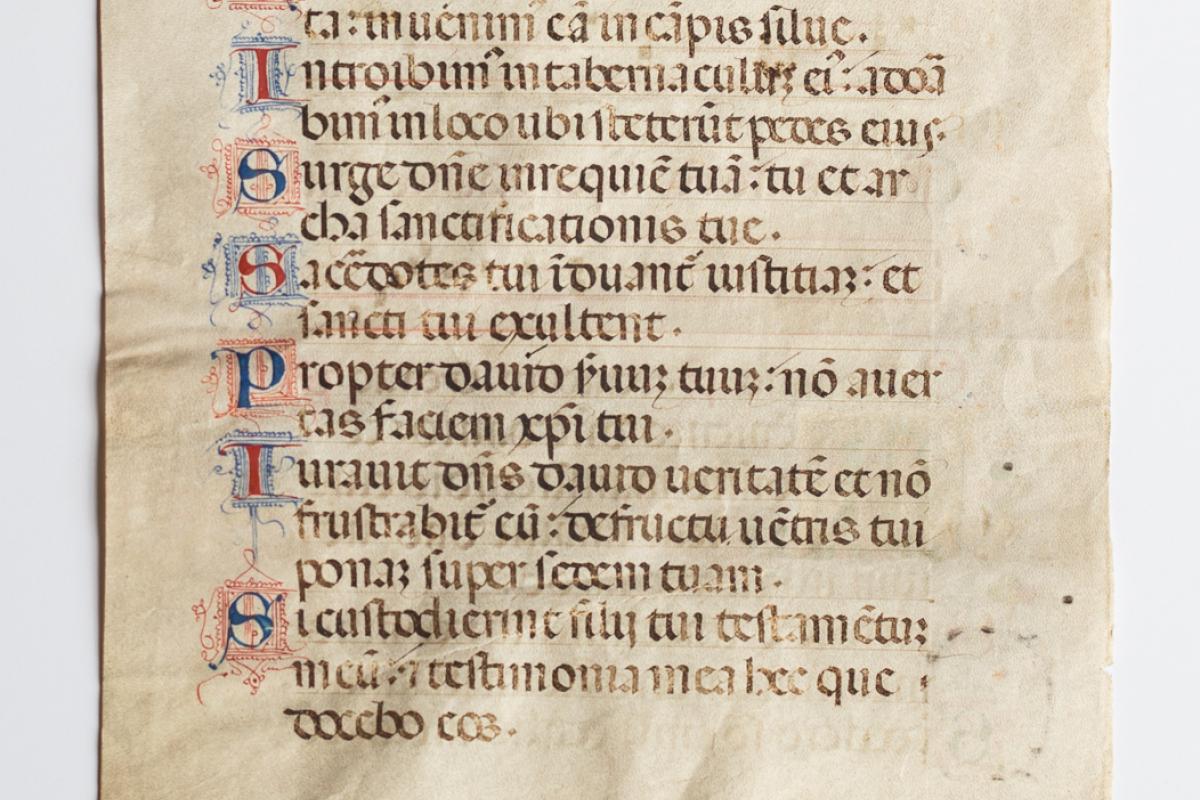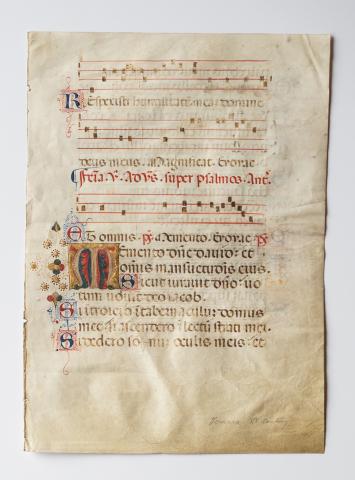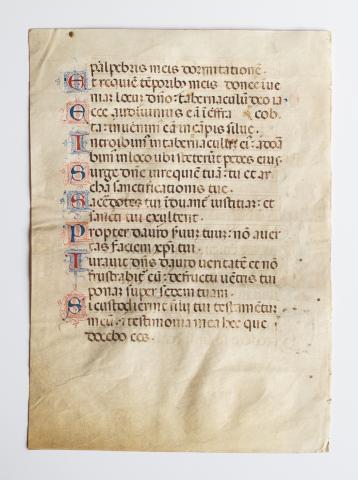Breviary Leaf
Breviary Leaf
Italian (Ferrara), 15th century
Single leaf
height 32.5 cm
width 23.5 cm
Samuel Babb, Medieval Portland Capstone Student, Summer 2014
This is a single vellum leaf from Ferrara's workshops, considered the best within Italy at the time[1]. There are uniform tears along the left-hand side of the leaf suggesting that it was originally part of a breviary, a liturgical book of the Roman Catholic Church. The breviary acted as the official prayer book of the church; it included appropriate readings, hymns, and psalms. This leaf contains Psalm 131 which is a vesper or evening prayer, for Wednesday[2].
Psalms were intended to be sung, and medieval singers reserved a technique known as faux bourdon, which translates to "false bass"[3]. This technique consists of cantus firmus, a pre-existing melody backed up by parallel sixths. This piece would have been sung in three parts--one to establish the song, the other to sing an octave under and one singer to sing half an octave between the other singers.
The recto of this leaf has three musical staves. Each staff has bold red lines and brown square notes, which have unfortunately begun to fade. Between the staves are one to two lines of Latin text. The line between the first and second stave reads: "Respexisiti humanitatem mean domine." This roughly translates to "Look courtesy of my lord." The first letter of this line, the "R," is written in blue ink and surrounded by a red box with decorated filigree. Under the second staff is the line: "Deus meus. Magnificat Erovae." In English this is: "My God, Magnificent Erovae." Follwed is: "Feria V ad vesperas. Super psalmos Ant," which is written in red ink. This line is directions, meaning: "On five in the evening. Psalms Ant." The final line reads: "Ob omnes. Ps. Memento EVOVAE Ps.." When translated, this line reads as: "Thanks to all. Ps. Remember Evovae Ps." The "Ps.'s are also written in red ink. Under this line, there is a large, elaborate gold "M" within a box. Inside the space of the "M" is a floral pattern. The outer left side of the initial is blue while the inside is read. The right side of the "M" inverses this. The top corners of the box contain two red flowers. The bottom corners have two green flowers.
Next to the gilded "M", there is a complex flower drawn in the margins. The flower consists of nine golden circles, two blue circles, two red circles, and a single blue--fourteen circles in total arranged symmetrically. The golden "M" initiates the beginning of the psalm: "Memento domine Dauid et omnis mansuetudinis eius Sicut iurauit domino uotum uouit deo Iacob. Si introito in tabernaculum domus mee si ascendero in lectum strati mei. Si dedero sonmum oculis meis et." This translates to: "O Lord remember David, and all his meekness. How he sware unto the Lord, and vowed a vow unto the God of Jacob: I will not come within the tabernacle of mine house, nor go into the bed wherein I lie; I will not suffer mine eyes to sleep." The page ends and the psalm continues on the reverse side.
The verso contains the psalm with nineteen lines of text. The parchment has faint brown lines underneath the calligraphy. Although printing existed in Italy at the time, the printing presses in Ferrara were limited.[4] It was favorable to commission a scribe to handwrite a piece. The faint lines helped the scribe keep the text neat.
The beginning letters of every two lines on the verso are decorated with boxed letters. Like the front, the decorated square lines alternate from red letter, blue square to blue letter, red square. The fourth line ends early and is followed with a symbol and a few letters. The symbol connects these few letters to the end of the third line of the text. The symbol acts like a modern-day hyphen and it continues the line without breaking it into the next.
The following is the text of the reverse side with its translation. The bolded letters are decorated squares.
Palpebris meis dormitionem
Et requiem temporibus meis donec in ueniam locum domino tabernaculum deo Iacob.
Ecce audiuimus eam in Effrata inuenimus eam in campis silue.
Introibimus in tabernaculum eius adorabimus in loco ubi steterunt pedes eius.
Surge domine in requiem tuam tu et archa sanctificationis tue.
Sacerdotes tui induantur iustitiam et sancti tui exultent.
Propter David seruum tuum non avertas faciem Christi tui.
Iurauit dominus David ueritatem et non frustrabitur eum de fructu uentris tui ponam super sedem tuam.
Si custodierint filii tui testamentum meum testimonia mea hac que docebo cos.
Translation
And the rest to my temples to my eyelids,
until he had fallen asleep in the veins of place for the Lord tabernacle for the God of Jacob.
Lo, We heard of it at Ephratah and found it in the fields of the wood.
We will go into his tabernacle, and worship in the place where his feet stood.
Arise, O Lord, into thy resting place; thou, and the ark which thou hast sanctified.
Let thy priests be clothed with righteousness, and let thy saints rejoice.
For the sake of David thy servant turn not away the face of thine anointed.
The Lord hath made a faithful oath unto David and he shall not make it void: of the fruit of thy womb shall I keep my covenant, and my testimonies that I shall teach them.
If thy children keep my covenant and my testimonies that I shall teach them.
Notes
[1] Lockwood, 29.
[2] www.breviary.net
[3] Lockwood, 256.
[4] Lockwood, 29.
Bibliography
Lockwood, Lewis, Music in Renaissance Ferrara, 1400-1505: the Creation of a Musical Center in the Fifteenth Century, Cambridge Harvard University Press, 1984.
"Making Manuscripts", E.Gentilli, 6:20, posted by the Getty Museum, http://www.getty.edu/art/gettyguide/videoDetails?segid=372.
http://www.breviary.net/commentps/commentps131.htm.
Wilma Fitzgerald, PhD, SP - Quoted with permission from an unpublished study
Breviary Psalter. Psalms for Vespers of Wednesday and Thursday. One vellum leaf. 325 x 235 (225 x 145) mm. Three lines of music with faded brown neumes on four red lines. Rubrics are red. Initials two lines high but set midline. Red or blue with filigree decorated square grounds. One large gold initial M with red and green leaf patterns. In lower corner: Ferrara XV century.
// [Music line] Respexisti humanitatem meam domine [music line] deus meus. Magnificat EVOVAE. Feria V ad vesperas. Super psalmos Ant. [music line] Ob omnes. Ps. Memento EVOVAE Ps. [131] Memento domine Dauid et omnis mansuetudinis eius Sicut iurauit domino uotum uouit deo Iacob. Si introito [introiero] in tabernaculum domus mee si ascendero in lectum strati mei. Si dedero sonmum oculis meis et
[verso]
palpebris meis dormitionem Et requiem temporibus meis donec in ueniam locum domino tabernaculum deo Iacob. Ecce audiuimus eam in Effrata inuenimus eam in campis silue. Introibimus in tabernaculum eius adorabimus in loco ubi steterunt pedes eius. Surge domine in requiem tuam tu et archa sanctificationis tue. Sacerdotes tui induantur iustitiam et sancti tui exultent. Propter David seruum tuum non avertas faciem Christi tui. Iurauit dominus David ueritatem et non frustrabitur eum de fructu uentris tui ponam super sedem tuam. Si custodierint filii tui testamentum meum testimonia mea hac que docebo cos [Et filii eorum usque in saeculum] //




